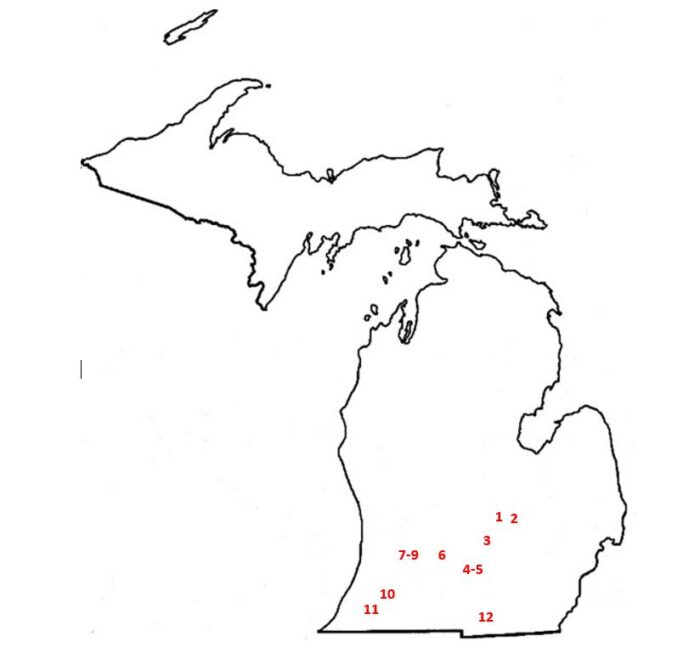


There’s still time to experience the beauty of Michigan’s Fall color splendor – and with it, the opportunity to take in some of the state’s most magnificent architecture along the way. For MAF’s Michigan Architecture Road Trip #5, let’s travel from Lansing to Hillsdale, taking a drive along a Southwest Michigan route. Buckle your seatbelts (virtual or otherwise), and let’s hit the road!
Each of the stops below is taken from MAF’s book, ‘Great Architecture of Michigan’, written by John Gallagher with photos by Balthazar Korab. In the book, you’ll find more information on each of the structures (and if you would like a copy of the book, you can purchase it directly from www.michiganarchitecuralfoundation.org).

1.Michigan State Capitol: Lansing, Page 26

One of the nation’s finest state capitol buildings. The opulent interior borrows freely from classical and High Victorian motifs. Thanks to the 1990’s restoration, the capital shines in all its glory.
http://www.capitol.michigan.gov/
http://www.capitol.michigan.gov/Tours
http://capitol.michigan.gov/Historical
2. Goetsch-Winckler House: Okemos, Page 156
A modest, one-story Usonian house with a strong horizontal emphasis, due in part to the stepped eaves and extreme cantilever of the roof over the carport.
http://www.michiganmodern.org/buildings/goetsch-winckler-house
3.Lester K. Kirk Collegiate Center: Olivet, Page 77
This modern landmark is located in the center of the Olivet College campus, the only building on a large grassy block. The building is slightly elevated with thin support columns that branch out to support the overhanging roof, both features that enhance the impression that the center is almost floating in space.
http://www.michiganmodern.org/buildings/olivet-college-collegiate-center
https://www.claasshaus.com/blog/midmod-monday-olivet-college-collegiate-center
4.Honolulu House: Marshall, Page 150
The Honolulu House serves as the home of the Marshall Historical Society and as the focal point of Marshall’s National Historic Landmark District. The building is a wonderful blend of Italianate, Gothic Revival and Polynesian architecture.
http://marshallhistoricalsociety.org/attractions/1
https://www.marshallmich.com/history/HonoluluHouse.shtml
5.Fitch House: Marshall, Page 153
One of Michigan’s oldest surviving buildings and a prominent example of Greek Revival architecture. The surrounding grounds were designed in 1921 by prominent Midwest landscape architect Jens Jensen.
https://sah-archipedia.org/buildings/MI-01-CA19
http://www.historic-structures.com/mi/marshall/brooks_house.php
6.Battle Creek Station: Battle Creek, Page 31
This noble station features a variation on the Richardson Romanesque style that includes red brick and Lake Superior sandstone, instead of the darker and heavier masonry more common to other 19th century depots. The dramatic upward thrust of the clock tower punctuates the otherwise low-lying horizontal plane.
https://www.greatamericanstations.com/stations/battle-creek-mi-btl/
7.Amariah T. Prouty House: Kalamazoo, Page 157
One of the state’s best examples of Gothic-inspired cottages. The house displays the elaborate scrollwork of the roof gable, the medieval-style bay window known as an oriel and the subtle Tudor arches of the veranda.
https://www.kpl.gov/local-history/kalamazoo-history/houses/elm-302-amariah-t-prouty-house/
8.Kalamazoo City Hall: Kalamazoo, Page 32
One of Kalamazoo’s finest examples of Art Deco architecture. Simple yet elegant, this limestone façade is decorated with tall fluted pilasters and relief panels showing both historical scenes and floral and geometric patterns.
https://sah-archipedia.org/buildings/MI-01-KZ2
9.Parkwyn Village: Kalamazoo, Page 189
In the late 1940’s Frank Lloyd Wright designed a cooperative community featuring more than 40 of his so-called Usonian Automatic houses. Only four Wright houses were actually built, but they typify Wright’s concern for homes that provide shelter, privacy, and a connection to the natural world.
https://www.parkwynvillage.com/
https://www.parkwynvillage.com/history
10.Gardner House (The Maples): Dowagiac, Page 171
This massive Romanesque Revival stone house is trimmed with local sandstone. The dramatically composed roof is covered in red clay tile. The interior was made for social gatherings with a two-story reception room.
https://sah-archipedia.org/buildings/MI-01-CS1
11.Niles Station: Niles, Page 12
The Niles Station was built for the Michigan Central Railroad in 1892 and was placed on the National Register of Historic Places in 1979. A picturesque Richardsonian Romanesque composition, this station is still in use by Amtrak.
https://www.greatamericanstations.com/stations/niles-mi-nls/
https://sah-archipedia.org/buildings/MI-01-BE15
12.Central Hall, Hillsdale College: Hillsdale, Page 72
This ‘wedding cake’ of a building remains the focal point of the Hillsdale campus and has symbolized the college and its values for decades. The building is a peculiar mix of an Italianate building gloriously topped with a French Second Empire roof.
https://www.hillsdale.edu/about/facilities/central-hall/
http://hillsdalecollegian.com/2017/09/history-legacy-central-hall/